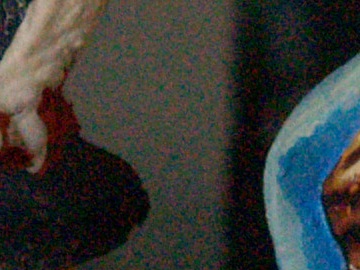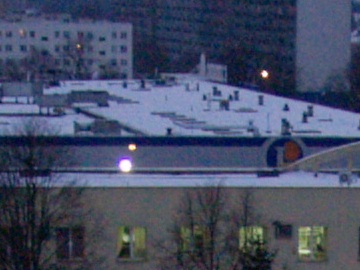
|
E-300 Noise Removal with Neat Image |

|
My other articles related to the |
|
This is just a quick note, showing the results of noise removal from E-300 images at ISO 1600 and ISO 800 (in the latter case I consider the removal optional; the noise isn't that bad). My application of choice to do that is Neat Image; you can download a functional trial version for free, with versions adding functionality available at $30 to $75; the same site provides lots of additional information, which I will not repeat here. (Another often recommended noise removal program is Noise Ninja, with which I am less familiar, as the trial version of that program is crippled.) On the left is a 1:1 fragment from an original ISO 1600 image shown in my E-300 Samples page. On the right is a similar fragment of the same image after it was processed with Neat Image at default settings (plus a slight sharpening). |

|
-f.jpg)
| |
| Fragment of an original ISO 1600 image straight from the camera. | A similar fragment of that image processed with Neat Image |
|
While some low-frequency (large-scale) chroma variation is still seen in the mid-tone background, the noise reduction is nothing short of dramatic, and the remaining high-frequency noise — quite acceptable. A scrutiny of the whole image does not show a noticeable loss of detail, or of contour sharpness. Some twiddling with the controls allowed me to remove the low-frequency chroma effect from the background, but at the expense of somewhat artificial, plasticky appearance of some areas, therefore I decided to keep the original result as shown. (I find the noise reduction feature in Photoshop CS less effective than Neat Image, while in Photo-Paint 11 it does not seem to work at all, and this remains not fixed in Version 12.) For those who are really fussy about noise, here is Neat Image applied to an ISO 800 sample from the E-300, shown in the same page. |

|
-f.jpg)
| |
| Fragment of an original ISO 800 image. | The same, after Neat Image. |
|
While the original image was much less noisy than before, the difference is also quite visible: the processed one is as smooth as baby's behind; even too smooth for my taste. I would rather stick with the original, or at least apply less denoising here, but this may be a matter of taste. Neat Image allow you to define separate noise profiles for individual camera settings and/or different applications, and then to apply them in a batch mode to whole series of images at once. These features are essentially available only in the paid versions of the program (which also add 16-bit support, a Photoshop plugin and other features, see the vendor's Web site for details). The program, currently in Version 4.4, is well-designed, and I found no issues with implementation; small, thoughtful touches (like flip-flop before/after comparison) are included in a number of places. Processing of an 8-megapixel file (in addition to noise profiling) takes about 30 seconds on an Athlon 3000+ processor. (Having written and programmed some image-processing algorithms in the past, I am not surprised or disappointed with that: the necessary amount of numerical work is just staggering. This also explains, why such smart and effective noise removal is not a part of camera's firmware, which runs on relatively feeble, low-power processors.) If you use your E-300 only occasionally to shoot low-light scenes at ISO 1600, you may easily get by with just a trial version of Neat Image. For a more frequent use, I would recommend buying the Pro version at $60 (or Pro Plus, if you use Photoshop and would like to get a plugin, at $75). Your money will be well spent. |

|
My other articles related to the |
|
Evolt® and Olympus® are registered trademarks of Olympus Corporation.
This page is not sponsored or endorsed by Olympus (or anyone else) and presents solely the views of the author. |
| Home: wrotniak.net | Search this site | Change font size |
| Posted 2005/01/17 | Copyright © 2005 by J. Andrzej Wrotniak |